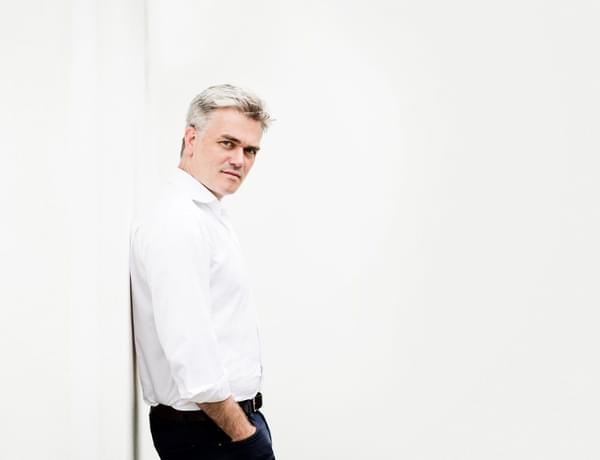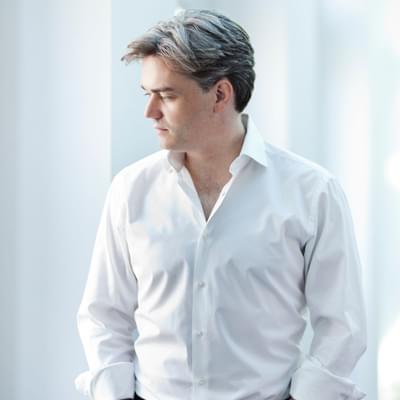Schubert 9

Full programme
- Schubert, Rosamunde Romanze
- Schubert (arr. Berlioz), Der Erlkönig
- Schubert (arr. Britten), Die Forelle
- Schubert (arr. Reger), Im Abendrot (20mins)
- Schubert, Symphony No.9 (57mins)
Performers

Edward Gardner
Conductor
Mary Bevan
Soprano
Introduction
For every student of singing, Schubert’s songs are the cornerstone of an education into the great world of German Lieder.
Described by Liszt as “the most poetic musician who ever lived”, this reputation is partly down to his huge output of over 600 songs over his short lifetime (he died aged 31), but mainly due simply to his extraordinary ability to bring poems alive through his music.
The range of techniques he uses to do this are reflected particularly well in the songs chosen for tonight’s concert, two of which are his best-known works; ‘Erlkönig’ was set up by Schubert himself to be published as his Opus 1, and consequently it became his most popular song, performed by male and female singers alike. It is interesting to note that Schubert’s chosen interpreter (Johann Michael Vogl) demanded extra bars of the famous galloping motif be inserted into one section of the accompaniment, so that he would be able to catch his breath!
Another of Schubert’s most popular lied, ‘Die Forelle’, is an excellent example of a strophic song; where many verses are repeated to the same tune (a nightmare for memorisation!), resulting in a building of intensity as the story unfolds and usually ending in a coda containing a ‘life lesson’
of some kind for the listener.
My personal favourite of this group is ‘Im Abendrot’; as in ‘Geheimes’ and ‘Romanze’, Schubert employs all his harmonic genius and understanding of poetry to balance the text with a simple yet timeless melody.
Even with just five of these songs side-by-side, one can see why the ‘Schubertiad’ became popular as evening entertainment in Schubert’s lifetime and still remains so into the present day; every poem sits in its own perfectly-crafted and private musical world, and since his output was so varied, one can sit and listen to an hour’s worth of these songs and be transported from each world to the next; the perfect escape from our busy lives.
Mary Bevan
Soprano
Programme Notes
Schubert was an absolute master of melody and his ‘lieder’ (songs) still pack a punch 200 years after he wrote them. In tonight’s performance, these songs range from the romantic to the terrifying, and Mary Bevan and Edward Gardner bring out every nuance in the vibrant orchestrations. Schubert’s Symphony No.9 (the last he wrote) is a suitably grand final word.
Rosamunde Romanze
Franz Schubert (1797-1828)
Der Erlkönig
(arranged by Hector Berlioz)
Die Forelle
(arranged by Benjamin Britten)
Im Abendrot
(arranged by Max Reger)
Franz Schubert was the most Viennese of composers – the son of a city schoolteacher, and a boy-chorister at Vienna’s Imperial Seminary. That all ended when his voice broke, and he scribbled the exact moment it happened in the score of the piece he happened to be singing at the time: “Schubert, Franz, croaked for the last time, 26th July 1812”. Reluctantly, he agreed to train as a schoolteacher; while privately aspiring to follow in the footsteps of Beethoven. Easier said than done for an unknown student from a lower middle-class family (he’d been mocked as a “millers’ boy” by his schoolmates because of his secondhand clothes). It was hard to get symphonies performed, let alone operas, and a young composer needs to earn a living as well as a reputation.
But Schubert did have one regular outlet for his genius. Like young people in any century, his Viennese friends were a lively, sociable bunch. Money might be short, but for entertainment all they needed was a piano and a friend (male or female) with a decent voice. Over the course of his short life, Schubert wrote more than 600 songs for voice and piano. Some he sold to publishers, others were intended for performance in coffeehouses and at the social gatherings that came to be known as “Schubertiads”. Viennese to their core, Schubert and his café followers understood that the most profound experiences in life can come from little things: a moment of solitude, a good cup of coffee, or a song shared with friends.
Schubert composed most of his songs for voice and piano, but we’re beginning with an exception When in late November 1823 he was commissioned to write orchestral music for a new play, Rosamunde, Princess of Cypress, he could hardly afford to refuse. Alas, Rosamunde seems to have been a turkey: “empty, tedious, unnatural” was one of the kinder reviews. Only Schubert’s music survives, including this Romanze: a song of moonlit love and longing, set to a lilting melody and accompanied by an orchestra that seems to sigh with all the tenderness of a spring night.
Yet within a few years of Schubert’s death, a new generation of composers began to appreciate the scale of what he’d achieved, and what music had lost. To a composer like the great French romantic Hector Berlioz (1803-1869), the piano seemed too small a vehicle for a vison as wild and powerful as Erlkönig (The Erl-King) (1815) – the 18-year old Schubert’s terrifying mini-drama of a father and son pursued on horseback by a malevolent spirit. In 1860, Berlioz transformed it into a miniature opera, complete with thunder and galloping strings. Beware: this dark fairytale does not end happily…
Die Forelle (The Trout) (1817) is an altogether more cheerful tale (unless you’re a fish), and Benjamin Britten arranged it in 1942 for a small orchestra that flows and bubbles like the stream in the poem. Anyone who knows Schubert’s “Trout” Quintet knows this tune, and Schubert’s Viennese friends loved the song so much that he often had to make copies for them to take home.
Schubert composed Im Abendrot (At Sunset) early in 1827, less than two years before his untimely death, and when it was first sung (at a Schubertiad at the house of his friend Josef von Spaun) his assembled friends were so moved that they immediately asked to hear it again. The German composer Max Reger (1873-1916) made this lovely orchestral version in 1914, just before the lights went out across Europe, though to a true romantic, of course, a prayer at sunset can have many meanings. The melody is deceptively simple; the emotions it conveys are almost limitless. Schubert still aspired to write symphonies, but by the end of his career as a songwriter, he could make even four minutes of music contain whole worlds.
Symphony No. 9 in C major (“Great”)
Franz Schubert (1797 – 1828)
I. Andante – Allegro, ma non troppo
II. Andante con moto
III. Scherzo – Allegro vivace
IV. Allegro vivace
When a piece of music is called “Great”, it’s not always helpful - you might prefer to be the judge of a piece’s greatness yourself. But Schubert never called his last completed symphony anything of the sort: in fact, he never even heard it performed. The nickname was coined long after his death, and in German, it simply means “large” (as opposed to Schubert’s considerably shorter “small” Symphony in C major, No.6). But it stuck because it makes a point. This symphony is big. It lasts a good hour, and the orchestra – unusually for the period – uses three trombones. When Schubert completed it, in March 1825 at the age of 28, no composer except Beethoven was thinking on anything like this scale.
No wonder contemporaries found it baffling. Schubert sent a copy of the symphony to Vienna’s leading concert promoters, who rejected it as “too long and difficult”. It was never played in Schubert’s own short lifetime, and lay forgotten until January 1839, when the composer Robert Schumann paid a visit to Schubert’s grave in Vienna. There wasn’t a single flower on it. “It occurred to me as I walked back to the city”, he recalled:
that Schubert’s brother Ferdinand still lived […] He knew me as an outspoken admirer of his brother, told me much and finally showed me some of his treasures, namely those of Franz’s compositions still in his hands. The assembled riches set me trembling with joy! Where to begin? Where to stop? He showed me, among other things, the scores of a number of symphonies, some still unheard, some examined and put away as too difficult and extravagant.
What happened next is well-established: Schumann rescued the score and Mendelssohn conducted the premiere of Schubert’s Great C major Symphony in Leipzig on 21st March 1839. Not everyone was convinced: the first London performance had to be abandoned when the musicians broke down in giggles. Within a short time, however, word started to spread that this was music on a new and magnificent scale. The nickname stuck – and no question, this symphony is still a huge challenge to its performers (musicians call it the “Great C Monster”).
The key, for the listener, is to embrace that scale – breathe out, stretch your imaginative limbs, savour the spaciousness. Schubert hit on an idea that’s still being explored in contemporary electronic dance music and “minimalist” compositions: the power of repetition. Time becomes space. The overall effect is like a journey through a vast landscape (Schubert loved walking in the Alps) – sometimes slowly, sometimes at breathtaking speed, but always moving forward. Schubert lays it all out at the very beginning. A noble horn call opens up huge vistas, then leads into a slow, expansive march that finally, deliberately, gathers momentum and accelerates into the symphony proper. In the first and fourth movements the music moves in huge paragraphs, and the two inner movements are on an equally grand scale.
In the Andante the oboe sings a bittersweet walking song that gradually builds to a story of passionate heartbreak. And then he walks on. The Scherzo that follows is a huge, whirling dance with an unmistakably Viennese swing. And finally, a vigorous call to action launches a massive, high-speed finale whose driving rhythmic patterns never once flag. Schubert briefly salutes Beethoven’s Ninth Symphony before peeling off and spinning away down his own, very different but equally mighty path - hurtling towards the finishing line with (in the words of the Scottish musicologist Donald Tovey) “the momentum of a planet in its orbit”.
© Richard Bratby
Featured image © Benjamin Ealovega